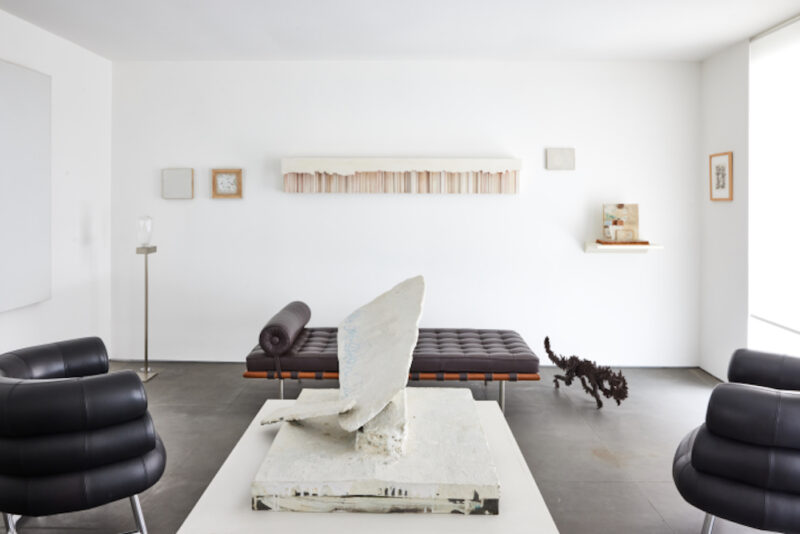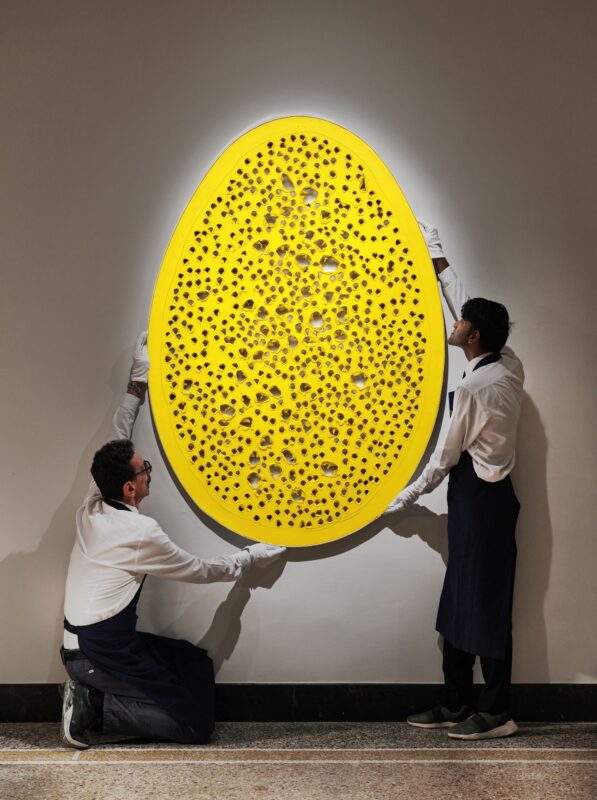
ImageBoris Grigoriev’s charming “Still Life with Cat and Onions”, circa 1928, a work that has been extensively published and exhibited (est. $300/400,000). Photo: Sotheby’s.
Sotheby’s spring 2010 sales of Russian Art will be held on April 21 and 22 in New York, and will once again present collectors with a wealth of exciting works from important private collections. Among the auction highlights is a group of paintings by Russian artist Pavel Tchelitchew from the collection of the late American actress, Ruth Ford (1911-2009) (collection est. $2 million, see separate release). Sotheby’s also announced the sale of the monumental Yakov Pereman Collection, an incredibly rare group of 86 works by the Ukrainian ‘Society of Independent Artists.’
The collection, which will be sold as a single lot, comprises some of the most important masterpieces by leading Ukrainian artists of the early 20th century (est. $1.5/2 million). Important paintings by Boris Grigoriev, Natalia Goncharova and Yuri Pimenov, among others, will also be offered. A section devoted to decorative objects features a collection of 40 works by Fabergé from an American estate that have been unseen on the market for several decades, as well as Two Russian Imperial Porcelain Vases with rare, Chinese-inspired decoration.
The cover lot of the April sale is Yuri Pimenov’s Morning Windows, a prime example of the artist’s cityscapes, which rank among the most highly sought-after images of the Soviet era (est. $250/350,000). His representations of everyday scenes unfolding against Moscow’s evolving skyline offer a unique commentary on the extraordinary socio-economic changes that were taking place in the country. Morning Windows is a classic example of his fascination with the dichotomy between the epic and routine, or as he titled his 1964 book, The Unusual Nature of the Everyday.
Classic images by Boris Grigoriev and Natalia Goncharova will also be offered, including Grigoriev’s charming Still Life with Cat and Onions, circa 1928, a work that has been extensively published and exhibited (est. $300/400,000), as well as Goncharova’s exquisitely decorative Still Life with Fish and Flowers (est. $300/400,000).
Ruth Ford and her brother, the late Surrealist poet and publisher Charles Henri Ford, were very close with Pavel Tchelitchew, and they inherited the artist’s estate upon his death in 1957. They remained ever dedicated to promoting his career, lending their treasures to exhibitions and continuing to amass an evolving collection of his pictures. Among the works by Tchelitchew that will be offered in April is Tattooed Man from 1934 (est. $250/350,000).
By the early 1930s, Tchelitchew began an extensive series of circus paintings depicting acrobats, jugglers, strong-men and other performers. Such choice of subject reflects Tchelitchew’s keen awareness of Picasso’s Blue and Rose periods, examples from which he had viewed firsthand in Gertrude Stein’s apartment. His limited palette serves to intensify the melancholic moods of his cast of curious characters, who appear to materialize from an eerie haze of gaslight colors: greens, blues and yellows. Tchelitchew’s brooding and hulking Tattooed Man epitomizes work from this period.
Also on offer is the artist’s Portrait of Ruth Ford (est. $100/150,000). In 1937, Tchelitchew began to focus more on portraiture, executing numerous, highly psychological images of his friends and contemporaries, including Constance Askew, Edith Sitwell, Lincoln Kirstein and Charles Henri Ford. Portrait of Ruth Ford was reportedly commissioned by the British poet, Surrealist art patron and renowned collector Edward James. Tchelitchew’s elegant portrait of Ruth captures both her beauty and naiveté. The eight hands which frame the composition each spell a letter of Ruth Ford’s name in American sign language, a theme employed frequently by the artist and his Surrealist contemporaries.
Russian Works of Art and Fabergé – 21 April 2010
A Rare and Important Fabergé Carved Lapis Lazuli and Gold Dolphin-Footed Bowl is the centerpiece of works by Fabergé from the Estate of Frances H. Jones to be sold this April (est. $50/70,000). Created around 1913 in the St. Petersburg workshop of Henrik Wigström, designer of many of the Imperial Easter Eggs, this neo-Renaissance style bowl is a significant example of one of the most rare and coveted styles in Fabergé’s historic repertoire. The fearsome dolphins and the skillful carving of the deep-blue lapis lazuli recall the hardstone vases and ewers carved for princely collectors in 16th-century Italy. The Jones collection comprises over 40 lots of Fabergé that were acquired in the 1960s and 70s, with many highlights once residing in the renowned Landsdell K. Christie collection.
Two Russian Imperial Porcelain Vases, Imperial Porcelain Manufactory, St. Petersburg, and period of Nicholas I (1825-1855), will also be offered in the spring auction (est. $200/300,000). The vases, of similar shape, are decorated in a Canton-style, with panels depicting warriors on one side and figures in a pavilion drinking tea and listening to musicians on the other. Vases with this type of Chinese-inspired decoration were quite rare during this period, making the appearance of these two examples on the market an exciting opportunity for collectors.
Following the recent success of Russian awards and orders at auction, Sotheby’s is pleased to offer an Imperial Order of the White Eagle, Eduard, St. Petersburg, circa 1906-1908, among the most important of the Russian Imperial Orders (est. $40/60,000). Although the precise date of the founding of the Order of the White Eagle remains the subject of some debate, most historians place its origins in the early eighteenth century. King Augustus II of Poland, whose rule was often challenged, needed a way to reward both his Polish and Russian noble supporters. With the partitioning of Poland, the Order fell by the wayside until Emperor Nicholas I revived it in 1831 as the Imperial and Royal Order of the White Eagle. The order was redesigned so that the original Red Cross and Polish White Eagle were set against a larger Russian Imperial double-headed eagle









